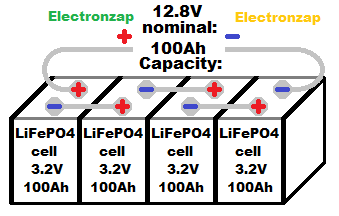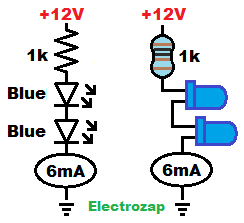Table of Contents
Some things to remember while using a 12V LiFePO4 (LFP) battery to power a small circuit.
Most people use factory built 12V batteries. They have 4 LiFePO4 cells connected in series and a BMS (Battery Management System) built into it a unit that just looks like a 2 terminal battery to the user. The BMS helps protect the battery in case something goes wrong.

- LiFePO4 is rechargeable.
- Don’t let it over discharge. It’s best to stop using a 12V LiFePO4 battery when it’s voltage drops to about 12V. Definitely stop using it if it drops to 10V as any lower voltage may damage it. Each cell can safely be discharged to no less than 2.5V.
- A 12V (12.8V) LiFePO4 battery is actually made with four 3V (3.2V) cells connected in series. As long as the cell voltages stay balanced, then they will each have a voltage of 1/4th of the total battery voltage. All 4 series cells need to have the same capacity (Ah). Cell can easily become unbalanced even if you are careful, so it’s best to not push the battery to it’s extremes.
- a “12V” LiFePO4 battery is commonly charged at 14.6V. The battery voltage will not be that high if it is not being charged, and it should not be held that high once it has become fully charged.
- Design your 12V LiFePO4 powered circuit to be able to safely handle at least 14.6V.
- Charging at the higher voltage (14.6V max.) than the fully charged resting voltage (13.6V) gets more stored charge into the battery. Charging should stop when current drops to a low amount as that is when the battery is fully charged.
- A 12V LiFePO4 battery that was just fully charged will have a resting voltage of 13.6V. After the charger is removed, the battery will quickly drop to 13.6V if it was charged at a higher voltage. Over time, the voltage will probably drift a little lower even when it is not being used to power anything.
- Nominal voltage of a 12V LiFePO4 battery is actually 12.8V (four 3.2V cells connected in series).
- 12.8V is a middle ground voltage. Most of the time the 12V LiFePO4 battery will be close to that 12.8V as it goes from fully charged to fully discharged. A partially charged battery has a relatively flat discharge rate.
- A built in BMS (Battery Management System) should prevent you from damaging the battery. But, it’s best to still use the batteries safely. Avoid purposely making the BMS protect the battery from abuse as much as possible.

Pages to example circuits:
Making more pages. Links will be added.
To support this site, check out the following links:
- Check out my YouTube videos! https://www.youtube.com/c/Electronzap/videos
- Products I used in my videos or otherwise think look like a good buy. As an Amazon associate, I earn from qualifying purchases. My Amazon affiliate page showing products I think look good
- Information on this site is not guaranteed to be accurate. Always consult the manufacturer info/datasheet of parts you use. Research the proper safety precautions for everything you do.
- Electronzap is a participant in the Amazon Services LLC Associates Program, an affiliate advertising program designed to provide a means for sites to earn advertising fees by advertising and linking to amazon.com.